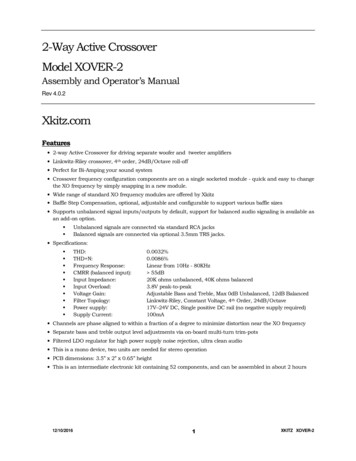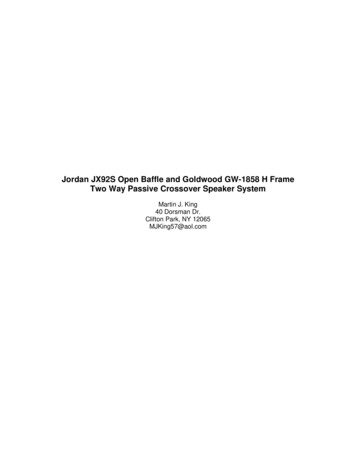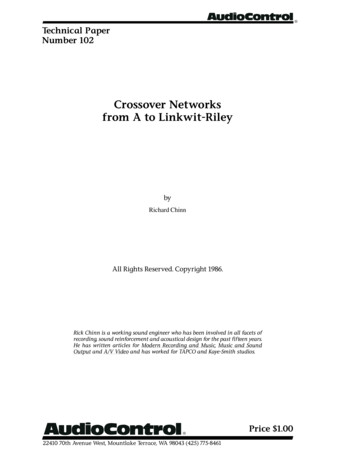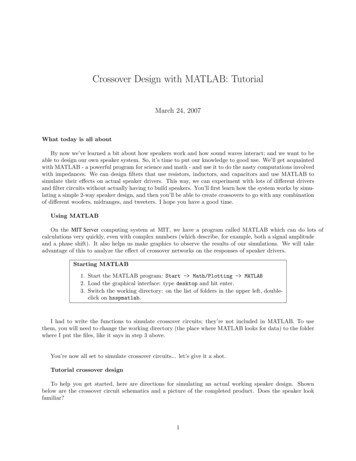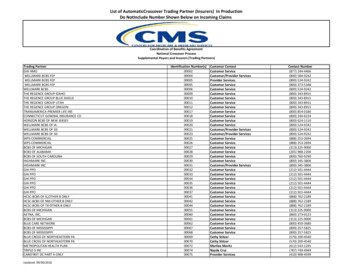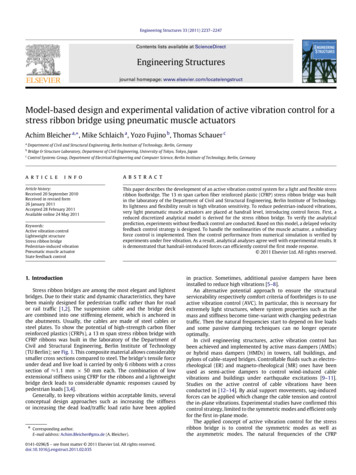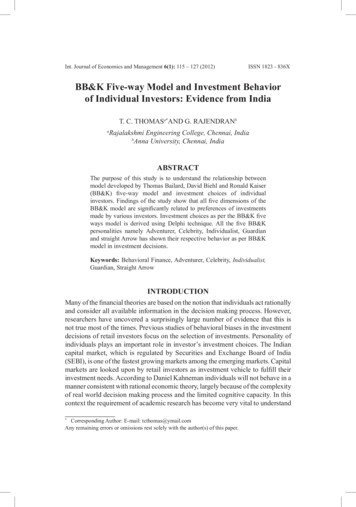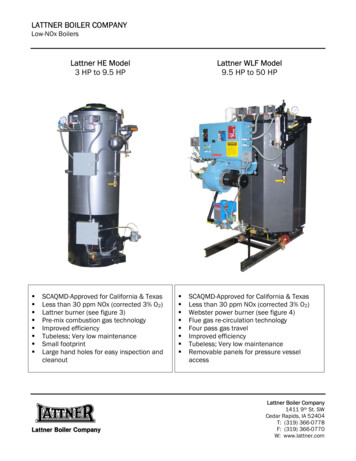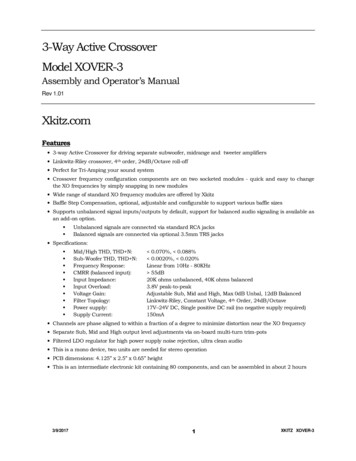
Transcription
3-Way Active CrossoverModel XOVER-3Assembly and Operator’s ManualRev 1.01Xkitz.comFeatures 3-way Active Crossover for driving separate subwoofer, midrange and tweeter amplifiers Linkwitz-Riley crossover, 4th order, 24dB/Octave roll-off Perfect for Tri-Amping your sound system Crossover frequency configuration components are on two socketed modules - quick and easy to changethe XO frequencies by simply snapping in new modules Wide range of standard XO frequency modules are offered by Xkitz Baffle Step Compensation, optional, adjustable and configurable to support various baffle sizes Supports unbalanced signal inputs/outputs by default, support for balanced audio signaling is available asan add-on option.Unbalanced signals are connected via standard RCA jacksBalanced signals are connected via optional 3.5mm TRS jacks Specifications:Mid/High THD, THD N:Sub-Woofer THD, THD N:Frequency Response:CMRR (balanced input):Input Impedance:Input Overload:Voltage Gain:Filter Topology:Power supply:Supply Current: 0.070%, 0.088% 0.0020%, 0.020%Linear from 10Hz - 80KHz 55dB20K ohms unbalanced, 40K ohms balanced3.8V peak-to-peakAdjustable Sub, Mid and High, Max 0dB Unbal, 12dB BalancedLinkwitz-Riley, Constant Voltage, 4th Order, 24dB/Octave17V–24V DC, Single positive DC rail (no negative supply required)150mA Channels are phase aligned to within a fraction of a degree to minimize distortion near the XO frequency Separate Sub, Mid and High output level adjustments via on-board multi-turn trim-pots Filtered LDO regulator for high power supply noise rejection, ultra clean audio This is a mono device, two units are needed for stereo operation PCB dimensions: 4.125” x 2.5” x 0.65” height This is an intermediate electronic kit containing 80 components, and can be assembled in about 2 hours3/9/20171XKITZ XOVER-3
What’s an Active Crossover and Why Do I Need It?Most speaker boxes have an electronic circuit inside them called a crossover. Its job is to split the sound intofrequency ranges; it sends the low frequency sounds to the woofer, and the high frequency sounds to thetweeter. This is important because each of the loudspeakers is built to produce certain frequency ranges, andthey don’t sound very good outside of their proper range.In fact, loudspeakers can actually distort within their natural frequency range if they are also presented withfrequencies outside their natural range. In other words if you send low frequencies to your tweeter, the highfrequency sound reproduced by the tweeter will be distorted by the presence of the low frequency signal.When you separate the frequencies with a crossover, each loudspeaker is able to focus on producing only thefrequencies that they’re designed to produce.Most speaker boxes you see have passive crossovers, which are made up of some inductors and capacitorsthat filter the low frequencies from the highs. But passive crossovers have a number of very significantdrawbacks. One big problem with passive crossovers is they don’t have a very sharp roll-off. This means thatsome of the bass frequency energy will still reach the tweeter, and some of the treble energy will still reach thewoofer. Another major disadvantage with passive crossovers is efficiency; they waste a huge amount of thepower you’re amplifier is providing. High frequency sounds are prevented from going to the woofer (and lowfrequencies prevented from going to the tweeter) by essentially just shorting them out; so power is wasted in theform of heat dissipated in the crossover components.But by far the biggest problem with passive crossovers is that they significantly degrade the quality of thesignals that pass through them by introducing distortion in the following ways: Channel phasing: Once the crossover splits the audio signal, the woofer and tweeter signals will be outof phase from each other (which means one leads or lags the other). This causes distortion at andaround the crossover frequency because at these frequencies both the tweeter and the woofer will bedriven, but each will be at a different phase. At various points of time in the wave the woofer andtweeter will be either fighting one another or re-enforcing one another. This leads to a muddying of thesound definition. Channel Cross-talk due to Back-EMF: The mass of the loudspeaker cones will continue to move in thedirection they are being driven by the amplifier for a short period of time after the signal changesdirection, and this induces currents in the voice coils that couple back into the passive crossover andcauses unpredictable non-linear crosstalk between the channels of the crossover. Frequency response degradation: any time you put large capacitors and inductors in series or parallelwith your audio signal it will invariably affect frequency response of the signals. The ways in which thiscan happen depend on the design of the crossover and the characteristics of the loudspeakers. Thenature of this distortion is so complex it becomes almost impossible to accurately model.All of this adds significant distortion to the final sound emitted. Audio engineers for decades have tried in vain tocome up with ever more complex passive filter arrangements to try and resolve, or mask, these inherentproblems.An active crossover, like the XOVER-3, on the other hand, is built from the highest quality operationalamplifiers (op-amps) and the filter functions are applied to the high impedance, line-level preamp input insteadof the low impedance, high voltage level amplifier output. Active filters have a much sharper roll-off,24dB/octave, allowing each of the loudspeakers to perfectly focus on producing just the frequencies they aredesigned to handle. Active crossovers are also more efficient from a power standpoint because of the fact thatthe filters are applied in the line-level audio input signal; only the energy meant for a particular driver is sent tothe amplifier that drives it, so there is no waste. But the biggest advantage of active crossovers is the soundquality. A vanishingly small amount of noise and distortion is introduced in the op-amp filter circuits, on theorder of 0.00005% total harmonic distortion.All of this results in extremely clean, precise, and well defined audio output to your amplifiers.3/9/20172XKITZ XOVER-3
Unpacking Your KitCarefully unpack and take stock of the components in your kit. The electronic components are packed in 2 bagslabeled ‘Bag A’ and ‘Bag B’. See Table 1 for a complete listing of your components.Assembly InstructionsIt is very important that you read and understand all of the following instructions before you start yourassembly so that you don’t make any mistakes that might be difficult to recover from. The assembly should bedone in the order listed in Table 1 or you may have difficulty physically accessing components for soldering.What you’ll needSoldering iron with small or medium tipDamp sponge for tip cleaningSolderSolder wick or solder sucker in case of solder bridging (stranded wire could substitute)Small needle nose pliers.Small wire cuttersSmall straight screwdriverSharp knifeMagnifying glass to read the markings on the tiny componentsGeneral Assembly GuidelinesTake your time!! Most mistakes are made when rushing through the assembly. Taking the time todouble check every step will pay off with a first-time functional device.In cases where it is necessary to re-form the leads on components (such as resistors and diodes),be very careful not to put stress where the lead enters the component itself. The physicalattachment of the lead to the component can sometimes be very fragile and the lead may break offif too much force is applied. Reforming the leads can be done by gripping the lead with smallneedle-nose pliers at the base of the component while bending the lead on the other side of thepliers.Use as little heat and solder as necessary to affix the components to the PCB (printed circuitboard). Many of the parts in this kit are temperature sensitive. Overheating may damage them.Always clean the soldering iron tip on the damp sponge prior to every solder joint. Re-tin wheneverthe tip gets a little dull. (tinning is the application of fresh solder to the tip of the iron until itsshiny, wipe excess on a damp sponge).Inspect the solder joints. They should be shiny and smoothly connect the pad to the lead. A dulllooking joint may indicate it is ‘cold’, meaning that either the pad or the lead weren’t heated enoughto allow reliable connection. This could lead to erratic operation of the device. Re-flow the jointagain with the soldering iron, apply equal heat to both the pad and the lead, apply a little moresolder if needed to get a good shiny connection.When clipping the excess leads of the through-hole parts, don’t try to clip too close to the PCB. Clipjust above the solder joint to avoid fracturing the solder joint, which could lead to device failuresometime in the future.Carefully inspect each solder joint to make sure you didn’t accidentally form a ‘solder bridge’, orconnect two adjacent pads together. Remove solder bridges by using solder wick or a solder sucker.If the bridge is small you may be able to remove it by just reheating the joint and sliding thesoldering iron across the bridge. If not, see the next step.If you need to remove solder from a hole (or a solder bridge) and you don’t have solder wick or asolder sucker, you can use stripped stranded wire in place of solder wick. Place the stranded wireacross the hole and touch the soldering iron to the wire, above the hole. As the wire heats it willmelt the solder in the hole, and the melted solder will tend to wick up into the stranded wire. Whenthe wire fills up with solder, move a clean part of the wire over the hole and repeat until the hole isclear of solder.3/9/20173XKITZ XOVER-3
Circuit Board AssemblyYou’re ready to begin assembling your XOVER-3 circuit board. Assemble the board in the order listed in Table 1.The components for the standard kit supporting UNBALANCED signal mode are in the bags marked ‘Bag A’ and‘Bag B’. If you purchased the BALANCED signal mode upgrade, you will have a second bag labeled ‘BalancedMode Upgrade’, which contains the components required to configure the XOVER-3 to support balanced inputsand outputs. Use the install check boxes on the right side to track your progress. The ‘Install Notes’ column willalert you to any special instructions (listed on the next page) for each of the components. We recommendreading and understanding all the design notes before you start your assembly.Table 1.Parts List - Bag A and Bag B – for standard kit supporting UNBALANCED signalingPack DeviceCIRCUIT BOARD (PCB)ValueREV 1.0MarkingXOVER-3Qty1K, ISTORCAPACITOR10K, 1%10K, 1%20K, 1%15, OR0.1uF, 10%1046CAPACITOR10uF, 10%106 (BLUE COLORED)10CAPACITOR0.015uF, 5%153 (BLUE COLORED)20BSC Configuration Cap:One of: (See Table 3).022uF 223.033uF 333.047uF 473SOCKET – 14 PINSOCKET – 8 PINSOCKET – 20 PINCOMPONENT CARRIER –20 PIN412U1,U2,U3,U5U4XO MODULE4452XO 8J10U678910TL074 or OPA42273U1,U2,U3,U511TL072 or OPA22271U4114ELECTROLYTIC CAPACIT.RCA JACKTERM BLOCK 2VOLTAGE 227Pack 6Parts List – Balanced Mode Upgrade – for the optional BALANCED signaling upgradeDeviceRESISTORRESISTOR3.5MM TRS JACKS3/9/2017122C22R10KTable 8,C29110KOP AMP CHIPSInstall 3TRIMPOTOP AMP atorsValue10K, 0.1%20K, J6,J9InstallNotes228Install XKITZ XOVER-3
Circuit Board Component Installation Notes:1.You will have extra 10K resistors after this step. These extras will be used in the next step.2.Install the 1% tolerance 10K and 20K resistors included in the standard kit ONLY if you’re running inUN-BALANCED input signal mode. If you purchased the optional BALANCED mode upgrade, thendiscard these 1% 10K and 20K resistors, and install the 0.1% tolerance 10K and 20K resistorsincluded in your upgrade packet instead.To configure the Baffle Step Compensation circuit, install the appropriate cap value in C22. There are3 possible cap values to install for C22, depending on your baffle size. See Table 3 below.3.4.Solder the three 14 pin sockets into the PCB to hold the op amps. Align the notches on one end of thesockets to the notches shown on the PCB silkscreen.5.Install the two 20 pin sockets in the locations on the board marked ‘MID/HIGH XO’ and ‘SUB XO’.Install with the pin 1 notch toward chamfered corner at the top of the MODULE. Carefully insert the20-pin component carriers into the 20-pin sockets. Solder the 10 resistors included in the XOcomponent packs for the Mid/High and Sub XO to the component carriers to configure your crossoverfrequencies. Use the parts placement diagram below and the instruction slip in your XO componentpacks to assemble the Modules. The 10 resistors in each pack are simply inserted across theappropriate component carrier and slipped into the two horizontally adjacent, fork shaped pins. Whenyou’ve double checked they’re all in the correct locations, solder them in place. Cut the excess leads.6.Install the multi-turn trim-pots in the orientation shown on the PCB pattern.7.The electrolytic capacitors are polarized devices, be sure to install them the right way around. Thepositive lead is longer than the negative lead. The positive lead goes in the square pad hole on the PCB.Note that the polarity is also marked on the outer casing of the cap.8.Install the RCA jacks in locations J1, J
When you separate the frequencies with a crossover, each loudspeaker is able to focus on producing only the frequencies that they’re designed to produce. Most speaker boxes you see have passive crossovers, which are made up of some inductors and capacitors that filter the low frequencies from the highs. But passive crossovers have a number of very significantFile Size: 474KBPage Count: 11
